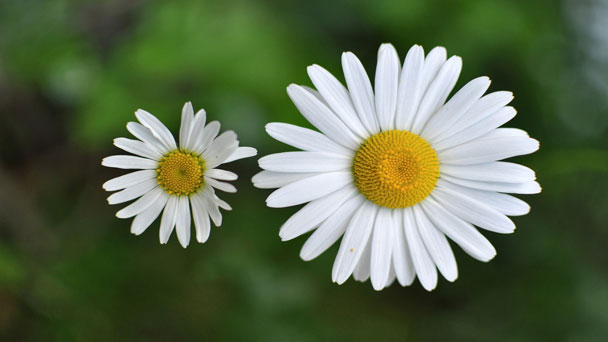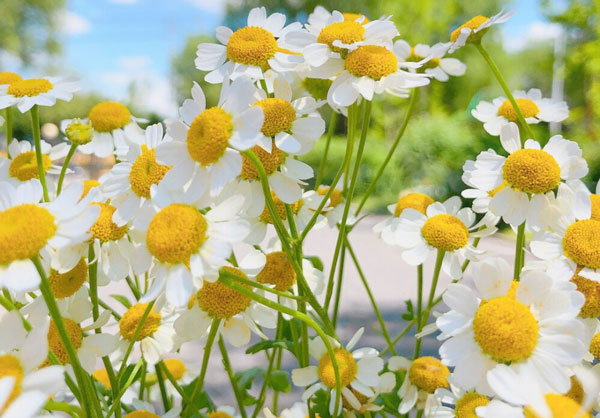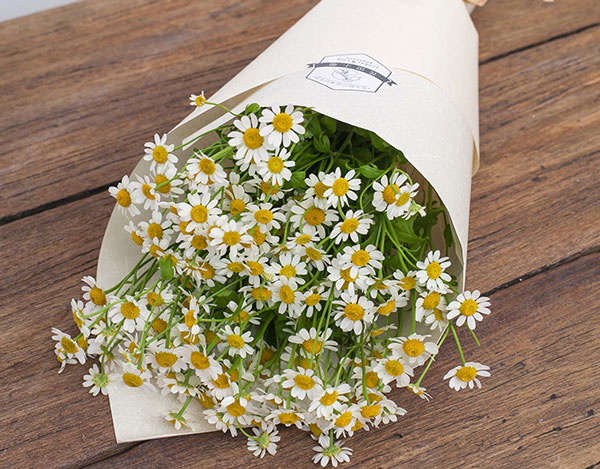Chamomile: Care & Grow Matricaria Recutita
Written by Iris
Dec 13 2022

Chamomile (Matricaria Recutita) is a plant of the Compositae family, native to Europe. They all have many characteristics in common: about 30 cm high, the center is yellow, the petals are white, and the leaves are slightly hairy.
Chamomile essential oil extracted from chamomile is also a very popular health care and pharmaceutical product. Because chamomile can help sleep, relieve inflammation and pain symptoms of patients, and relieve insomnia caused by neuropathic skin itching.
These plants do best with occasional, deep watering at base level. If you use a sprinkler system, be sure to irrigate early in the morning so that the specimens will have all day to dry out before dark. This helps prevent fungal infection and other diseases.
Aphids can chomp down on chamomile.
Powdery mildew is the most common problem with scented mayweed, but it is a concern only when the weather is hot and damp for prolonged periods of time. Aphids, thrips, and mealybugs can bother M. chamomilla as well, but the plant is generally pest and problem free.
It can even be processed and turned into an effective spray to aid your other garden plants. Make a batch of tea at triple or quadruple strength, allow it to steep overnight, and use it the next day as an herbicide and aid against mildew.
Roman chamomile (Chamaemelum nobile) – Low-growing, leafy perennial, the "original chamomile" doesn't produce as many blooms, makes a good groundcover.
Dyer's chamomile (Cota tinctoria) – Perennial, its all-yellow flowers are best for making dye.
Wild chamomile (Matricaria discoidea) – Also known as pineapple weed, native to Asia and naturalized in the U.S., grows along roadsides and other disturbed areas, not grown in gardens.
It's best to plant chamomile in a terracotta pot for better aeration and drainage. Check the soil frequently. It should not be allowed to dry out completely; however, you must also guard against over-watering as this causes root rot.
Chamomile essential oil extracted from chamomile is also a very popular health care and pharmaceutical product. Because chamomile can help sleep, relieve inflammation and pain symptoms of patients, and relieve insomnia caused by neuropathic skin itching.
How to Grow Chamomile (Matricaria Recutita)Steps for Chamomile (Matricaria Recutita) Propagation with SeedsSteps for Chamomile (Matricaria Recutita) Propagation with Stem CuttingsHow to Care for Chamomile (Matricaria Recutita)LightSoilWaterTemperature and HumidityFertilizerPests and DiseasesVarieties of Chamomile (Matricaria Recutita)Chamomile (Matricaria Recutita) FAQIs Chamomile A Good Container Plant?Does Chamomile Make You Sleepy?
How to Grow Chamomile (Matricaria Recutita)
Steps for Chamomile (Matricaria Recutita) Propagation with Seeds
Chamomile seeds can be started indoors 3-4 weeks before the last frost. When planting chamomile seeds indoors, fill a seed tray with a well-draining potting mix, then simply scatter the seeds over the loose soil and lightly tamp it down or water it in with a light mist. Seedlings should be thinned to 2-4 inches (5-10 cm.) apart when they are about an inch (2.5 cm.) tall. Plants do not like to be transplanted once their roots have been established and they begin to produce blooms, so many gardeners prefer to sow the seeds directly in the garden. In the garden or as a lawn substitute, chamomile seeds need only be scattered over loose soil and gently tamped down. Germination can occur in temperatures as low as 45-55 F. (7-13 C.) in full sun to part shade.Steps for Chamomile (Matricaria Recutita) Propagation with Stem Cuttings
When grown as a perennial, all species of chamomile propagate reliably from stem cuttings taken in spring. However, the cuttings must be harvested from the base of the stems and include a small amount of subterranean growth to ensure successful rooting.- Water the Daisy-Like chamomile plant deeply before gathering cuttings from it. Run water at the base of the plant for five to 10 minutes, or until the soil feels very wet at a depth of 3 inches. Let the water soak in overnight, then gather the cuttings the next morning.
- Locate a 4-inch-long chamomile stem with plenty of foliage, no flowers and a thick, unblemished base. Dig into the dirt at the base of the stem using your fingers to reveal the underground portion of the stem, which is whitish in color with small roots emerging from the bottom.
- Sever the stem 1/2 inch below ground level using a clean, sharp gardening knife. Wrap the base of the cutting in a sheet of moistened paper towel and place it in a shady spot to keep it hydrated while preparing the planting container.
- Fill a 4-inch pot with a mixture of 3 parts potting soil and 1 part perlite. Pour water onto the soil to settle it. Press the surface of the soil mixture to remove the excess water. Let it drain for five to 10 minutes.
- Poke a 2-inch-deep hole in the center of the soil mixture. Unwrap the paper towel from around the base of the chamomile cutting and insert the bottom 2 inches into the hole. Push the soil in against the stem to hold it upright.
- Root the chamomile cutting in a lightly shaded greenhouse or cold frame. Water it once a week to a depth of 1 inch. Watch for signs of growth in six to eight weeks. Transplant the rooted cutting into a sunny, well-draining garden bed four weeks after new growth emerges.

How to Care for Chamomile (Matricaria Recutita)
Light
Both Roman and German chamomile grow well in either full sun or partial shade. The plants will flower best in full sun, but in hot climates, a bit of partial shade is a better choice (especially during the hot afternoon hours) to avoid burning the delicate blooms. More sun typically leads to faster growth, but as this plant grows rapidly by nature, this may not be an issue.Soil
Before planting chamomile, prepare your garden bed by adding compost or other organic material to the soil, especially if your soil is primarily clay or sand. Chamomile prefers rich soil with a pH ranging from 5.6 to 7.5. To give your chamomile a great start, add aged compost-enriched Miracle-Gro® Performance Organics™ All-Purpose In-Ground Soil to your garden bed. Organic matter like this helps the soil retain moisture while also improving drainage, which is especially important with clay soil.Water
Check the soil every few days to determine whether you need to water. Once established, they are quite drought tolerant. Water as you would most wildflowers by watering with a slow trickle, through a soaker hose or using a drip watering system.These plants do best with occasional, deep watering at base level. If you use a sprinkler system, be sure to irrigate early in the morning so that the specimens will have all day to dry out before dark. This helps prevent fungal infection and other diseases.
Temperature and Humidity
Chamomile is capable of thriving in any summer weather under 100 degrees Fahrenheit. That being said, it prefers a moderate temperature range between 60 degrees Fahrenheit and 68 degrees Fahrenheit. Because it's drought-tolerant, it does not require special humidity considerations.Fertilizer
This easy-to-grow herb doesn't require a lot of fertilizer. In fact, avoid growing chamomile in nitrogen-rich soil or adding fertilizer, which can promote more leaves and fewer blooms.Pests and Diseases
Although M. chamomilla is relatively carefree and tough, it attracts pests and suffers from diseases like any other plant. However, as with most plant diseases and pests, proper care and attention to watering minimizes any of these potential headaches you could encounter.Aphids can chomp down on chamomile.
Powdery mildew is the most common problem with scented mayweed, but it is a concern only when the weather is hot and damp for prolonged periods of time. Aphids, thrips, and mealybugs can bother M. chamomilla as well, but the plant is generally pest and problem free.
It can even be processed and turned into an effective spray to aid your other garden plants. Make a batch of tea at triple or quadruple strength, allow it to steep overnight, and use it the next day as an herbicide and aid against mildew.

Varieties of Chamomile (Matricaria Recutita)
German chamomile (Matricaria camomilla or Matricaria recutita) – Annual, with an upright habit and profuse white-and-yellow blooms, good for making tea.Roman chamomile (Chamaemelum nobile) – Low-growing, leafy perennial, the "original chamomile" doesn't produce as many blooms, makes a good groundcover.
Dyer's chamomile (Cota tinctoria) – Perennial, its all-yellow flowers are best for making dye.
Wild chamomile (Matricaria discoidea) – Also known as pineapple weed, native to Asia and naturalized in the U.S., grows along roadsides and other disturbed areas, not grown in gardens.

Chamomile (Matricaria Recutita) FAQ
Is Chamomile A Good Container Plant?
It is easy to grow either type of chamomile in containers, and both are fine container plants. Your choice will depend on the results you want. If you want an upright plant go with German chamomile. If you want a cascading plant, Roman is best. For either one, be sure to use a light soil mixture. A succulent mix is ideal as it allows good air circulation and excellent drainage. Alternately, you can mix regular potting soil with perlite and/or coco coir to create a well-drained soil mixture.It's best to plant chamomile in a terracotta pot for better aeration and drainage. Check the soil frequently. It should not be allowed to dry out completely; however, you must also guard against over-watering as this causes root rot.
Does Chamomile Make You Sleepy?
Chamomile is particularly effective at making you feel sleepy because of its chemical structure. The plant extract contains apigenin, a chemical compound that induces sleepiness when it binds to the GABA receptors in the brain.Latest Updated
- Benefits of Bugleweed - 7 Science-backed Health Benefits
- Bugleweed Dangers & Side Effects - Is It Poisonous?
- How to Plant Evergreen Trees - What You Should Know
- When to Plant Evergreens - Grow Guide for Evergreen Trees
- 12 Wonderful Evergreen Shrubs for Your Garden
- 12 Popular Evergreen Plants with Pictures for Beginners
- When And How To Prune A Lilac Bush Like a Pro
- How to Grow & Care for Lilac Vine (Hardenbergia Violacea)
- Japanese Lilac Tree (Syringa Reticulata) Care & Propagation Guide
- Shumard Oak Pros and Cons - What to Know
Popular Articles
- Winter maintenance of Antirrhinum Majus
- How to Grow Terminalia Mantaly Tree
- How to Grow and Care for Crossostephium Chinense
- How to grow Antirrhinum Majus in spring
- Peristeria Elata (Dove Orchid) Profile: Info & Care Guide
- Underwatered Snake Plant (Sansevieria Trifasciata) - Signs And How To Fix
- How to Care for Brazilian Jasmine Plant (Mandevilla Sanderi)
- How to Grow & Care for Graptopetalum Purple Delight in Summer
- Rosa Chinensis (China Rose): Plant Growing & Care Tips
- How to Care for Baby Sun Rose (Aptenia Cordifolia)